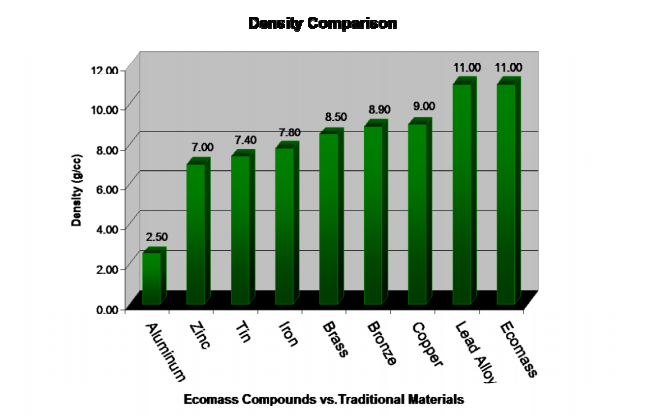Choosing the right high density material for your application presents all kinds of benefits. These non-toxic, polymer-metal compounds can be used to replace traditional metals as well as lead in areas such as radiation shielding, balancing, vibration dampening and weighting. Here’s a short guide to help you choose and work with materials that allow you to take your applications to the next level.
Why Choose High Density Materials?
The world is finally accepting high density materials with open arms as safety concerns, environmental issues and health precautions drive the demand towards replacing metals. There is also a need to replace metals while ensuring an increase in part density as metals are becoming more and more costly and complicated. High gravity compounds present excellent benefits such as sustainable formulations, non-toxic solutions and an outstanding balance of properties.
Great, Lets Choose One for My Application Requirements
While working with high density materials is easy, choosing the right material requires specialized knowledge. A number of factors need to be considered, the least of which include barrel temperature, desired molding method, processing speed, part handling and tool design. Moreover, the choice of high-density filler and polymer matrix also has far reaching effects on the properties of the material and how effective it is in meeting the various application requirements.
The Case of High Specific Gravity
Every high density formulation designed to replace metals and lead needs to have a high specific gravity that varies between 2 to 11. Replacing traditional metals with these materials allows you to add weight without compromising on part geometry. In other words, you can maintain the volume and part geometry, while adding to the overall part weight for higher quality, balance or momentum. For example, choosing materials with a high specific gravity of 2.6 will lead to an increase of 0.4 lb in part weight. Similarly, a specific gravity of 11 will to an increase of as much as 2 lb. A heavier weight appeals one’s perception of the product, and this immediately screams quality. A simple example is replacing zinc die-cast knobs with high gravity compounds to achieve a heavier weight without compromising on volume, part design or efficiency.
Lead Free Economies
Lead has emerged as one of the main substances of concern due to the countless health, safety and environment concerns. The use of lead is highly regulated in most countries and this makes it a lengthy and costly affair. There are risks for individuals working with products containing lead to factor into the picture as well. This is where densified materials can provide great value. These densified plastics can and are being used to replace lead in a wide variety of applications, including the introduction of lead-free applications in x-ray equipment and ammunition and much more.

Getting Back to the Basics
1.) The first step towards selecting the right high density material is to determine your application requirements. There are all kinds of options as you can easily combine different resins to different additives to get the desired outcome. A few factors that demand your attention are:
• Electrical performance to environmental exposure
• Mechanical performance to environmental exposure
• Aesthetics
• Regulatory standards or industry requirements, if any
2.) The next step is to design the mold. High gravity compounds have a tremendous impact on your mold design and certain adjustments/ alterations may be needed, irrespective of whether you use hot or cold runner systems or whether you choose two-plate or three-plate molds. For example, the type of steel used in the mold is very important. If you’re working with low-volume and low specific gravity materials, the P20 standard works perfectly. However, higher specific gravities may demand standards such as H13 or S7.
3.) Choosing between cold runner and hot runner systems is equally important. Adding a densified material into the mix will most likely increase the thermal conductivity of your matrix. Therefore, you need to prevent the flow front from causing high-pressure situations or freezing earlier than usual. In a cold runner system, this can be achieved with short flow lengths. Remember, your new material is more brittle, and it may break or crack if the flexing is high during the demolding process. If you’re working with hot runners, you need to ensure that the melt flow is thermally and mechanically balanced. Avoid valve gates as the shut-off provided by these materials isn’t as free-flowing as traditional plastics.
4.) The flow front needs to be kept open for as long as possible to minimize shear. This can easily be achieved by using diaphragm gates having 60 – 80 percent wall thickness.
5.) You do not need to invest in expensive cooling systems. The higher thermal conductivity helps to reduce cooling time.
Remember, when working with high gravity compounds, you also need to provide uniform pressure across the part while it is being pushed out of the cavity. Minimizing the falling distance to the conveyor or the bin and robotic/ manual handling helps reduce the risk of damage.






0 comments:
Post a Comment